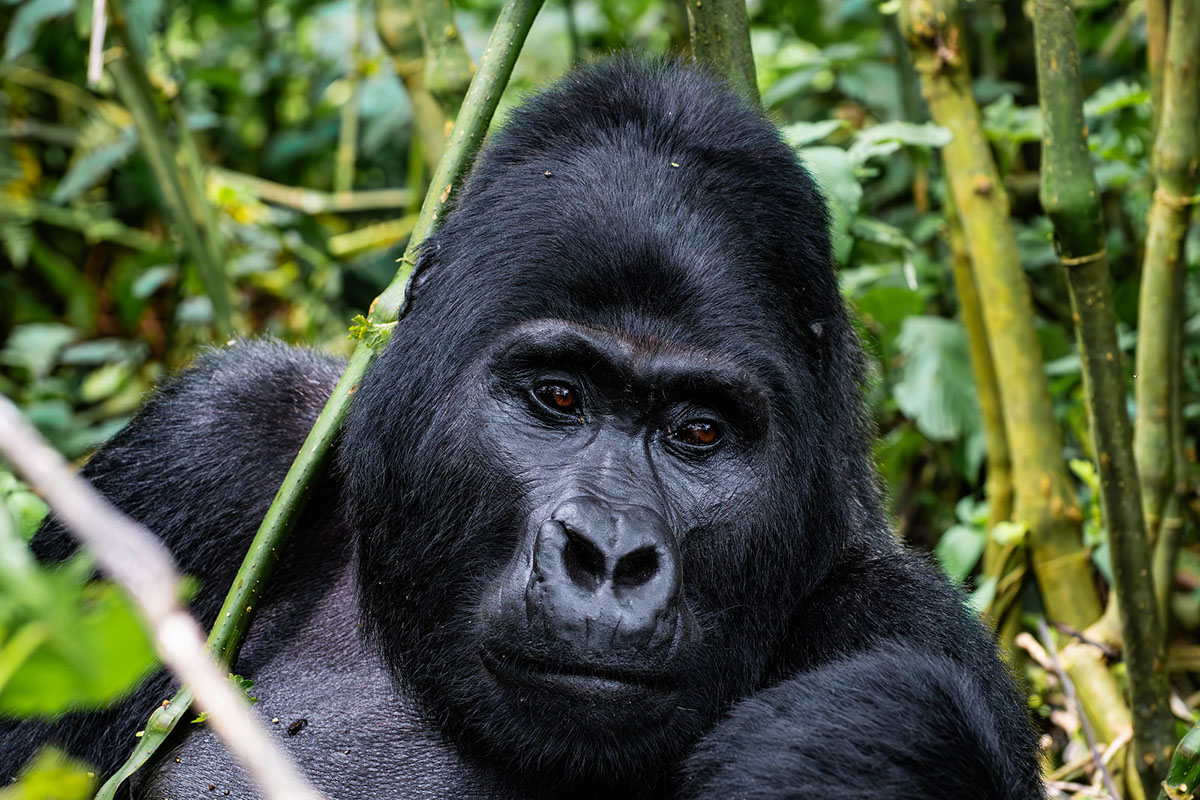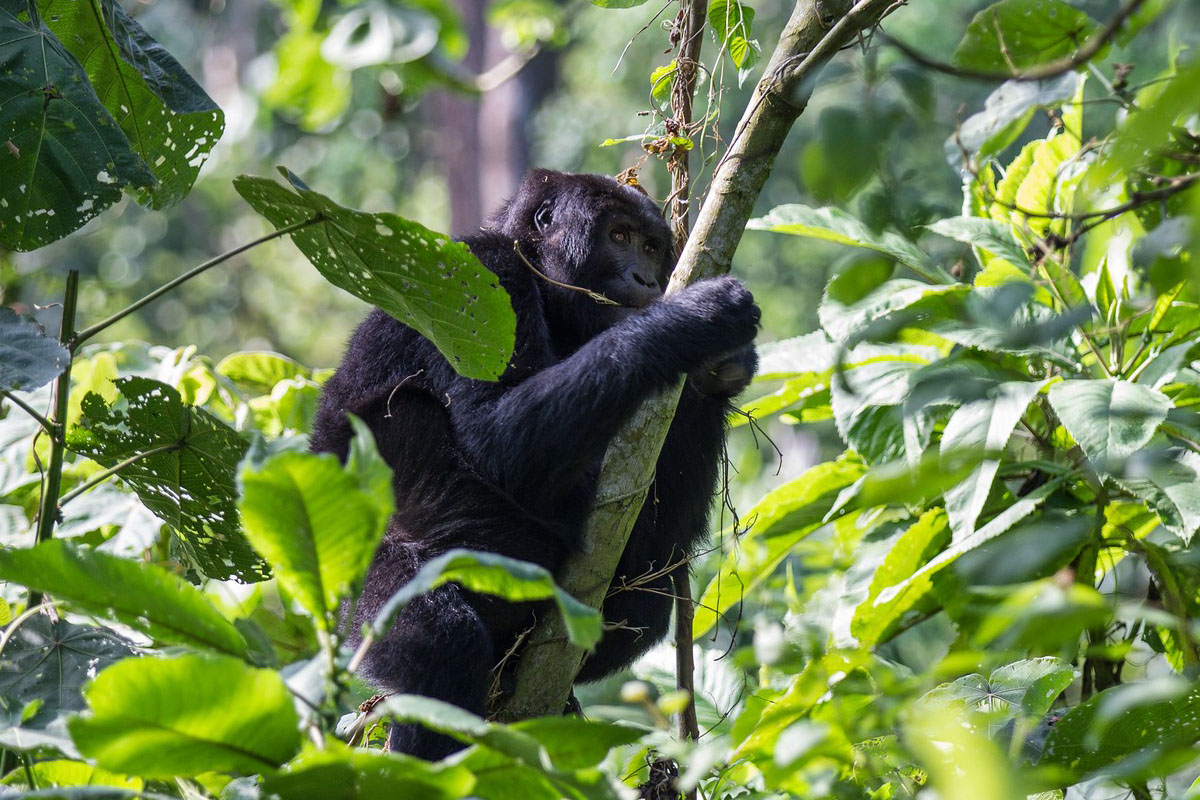
Trekking Gorillas in the Buhoma Region of Bwindi
October 15, 2024
Mountain Gorilla Families in Bwindi Impenetrable National Park
October 15, 2024Rwanda’s Mountain Gorilla Families in Volcanoes National Park
Tracking mountain gorillas in Rwanda’s Volcanoes National Park is truly a once-in-a-lifetime experience and one of Africa’s most unforgettable adventures. The thrill of seeing a wild mountain gorilla for the first time is hard to describe. These majestic creatures are massive; silverbacks can weigh up to three times as much as the average person, their imposing size accentuated by their thick, shaggy coats. Yet, despite their formidable appearance, gorillas are incredibly gentle animals. In fact, they are far more peaceful than many other primates. If gorillas had the temperament of vervet monkeys or baboons, the experience of tracking them would be quite different!
Gorilla Trekking in Rwanda
What sets gorillas apart is not just their size but also their fascinating interactions with humans. Visitors often feel a profound connection with these creatures, almost as if they recognize us. Many recount moments when a gorilla pauses its bamboo munching to gaze at them with its soulful brown eyes, seemingly searching for a bond.
Gorillas often approach their human visitors with curiosity. On several occasions, they’ve touched our guides as a form of greeting, highlighting their gentle nature. I’ve seen young gorillas show great interest in cameras; one large female even walked up to a tripod, inspected it closely, and then wandered off, seemingly satisfied. It’s as if the gorillas see their human visitors as fellow members of their community—too passive to pose any threat. Occasionally, a playful young gorilla will perform a chest-beating display as it walks past, comfortable in its dominance over us.
However, it’s crucial to remember that close contact with humans poses risks to gorillas, particularly regarding the transmission of diseases. To mitigate this, guides enforce a minimum distance of five meters between visitors and gorillas. Yet, the gorillas don’t always adhere to these rules, often approaching us out of curiosity.
The Adventure of a Lifetime
The magical hour spent with these incredible animals does come at a cost, and reaching them can be quite challenging. The trek to their preferred habitat in the bamboo forest includes steep inclines, dense foliage, slippery trails, and high altitudes. However, most reasonably fit adults of any age can visit the more accessible gorilla groups. In my 15 years of travel across Africa, I’ve yet to meet anyone who regretted the investment—either in time or money—after embarking on a gorilla tracking adventure.
Guidelines for Visitors While Tracking Gorillas in Rwanda
When embarking on a gorilla trekking adventure in Rwanda, it’s essential to follow certain guidelines designed to protect the health and safety of these magnificent mountain gorillas. These incredible creatures are highly susceptible to human diseases, and their well-being can be compromised by too many visitors or close encounters. Remember, they are wild animals, and their young are especially vulnerable. To thrive in their natural habitat, gorillas need to be able to eat, rest, and socialize without disturbances from humans.
Visitor Guidelines
- Health Matters: If you’re feeling unwell, park staff have the authority to deny you access to the gorillas. Your health is critical to protecting these animals.
- Limited Visits: Each group of tourists is allowed only one visit per day, and the number of visitors is restricted to either six or eight per group.
- Age Requirement: Visitors must be at least 15 years old to participate in gorilla tracking.
- Time Limit: You’ll have one hour to spend with the gorillas, so make the most of this extraordinary experience!
- Photography Rules: Flash photography is strictly prohibited to avoid startling the gorillas.
- Maintain Distance: Keep a distance of at least seven meters from the gorillas at all times. If a curious juvenile approaches to within two or three meters, gently back away to five meters. If that’s not possible, remain where you are and follow your guide’s instructions. Also, store your backpack and personal items in a safe place to prevent young gorillas from investigating.
- Stay Together: It’s important to remain in a tight group and avoid spreading out or surrounding the gorillas.
- Sit or Crouch: When watching the gorillas, try to sit or crouch to minimize your presence.
- Mind Your Body Language: Avoid raising your hands, pointing, or staring directly at the gorillas, as this can be perceived as threatening.
- Respect Their Space: Do not clear vegetation to get a better view of the gorillas.
- Stay Calm: If a silverback gorilla beats its chest or charges, do not run. Your guides will advise you on how to respond.
- No Eating or Drinking: Consuming food, drinks, or smoking near the gorillas is not allowed, and you must maintain a distance of at least 200 meters from them.
- Be Quiet: Keep noise to a minimum and speak softly. If you encounter safari ants or stinging nettles, resist the urge to scream.
- Cough or Sneeze Responsibly: If you need to sneeze or cough, turn away from the gorillas and cover your nose and mouth.
- Dispose of Waste Properly: Any waste must be buried. Guides can provide you with a machete to dig a small hole (approximately 30 cm deep) to dispose of it.
- Leave No Trace: Ensure that all rubbish is removed from the park. Be especially cautious not to drop small items like film canisters, tissues, or handkerchiefs.
Rwanda’s Mountain Gorilla Families
Rwanda is home to ten groups of mountain gorillas, each with its unique history and characteristics. Here’s a glimpse of two of these remarkable families, based on the latest census data.
Susa Group – 28 Gorillas
Originally boasting over 40 members, the Susa group now consists of 28 gorillas, including three silverbacks. This group is famous for having rare twins born twice, with the last occurrence on May 19, 2004. The female, Nyabitondore, successfully raised both twins, marking a significant achievement in gorilla conservation. The Susa group can be reached after a 3 to 4-hour trek from the park entrance.
Sabyinyo Group – 18 Gorillas
Comprising nine gorillas, including one silverback, this group has a rich history. Formed after the death of its previous leader in 1992, Sabyinyo was initially known as “Amavubi,” meaning “wasps,” due to the challenges faced during its habituation. Named after the mountain where it was first located, this group is known for its gentle nature and the largest silverback in the world. The trek to see the Sabyinyo group takes about 1 to 1.5 hours from the park entrance.
Amahoro Group – 17 Gorillas
The Amahoro Group, which translates to “peace,” is home to 17 gorillas, including 1 silverback, 2 blackbacks, 2 sub-adults, 5 adult females, 5 babies, and 2 juveniles. Established for tourism in 2000, this group is known for its gentle demeanor, particularly the relaxed and approachable silverback. The trek to locate the Amahoro Group typically takes about 1 to 1.5 hours from the park entrance, offering visitors a unique opportunity to observe these magnificent creatures in their natural habitat.
Group 13 – 26 Gorillas
Contrary to its name, Group 13 consists of 26 gorillas, including 1 silverback, 11 females, 4 juveniles, and 2 babies. The name originates from the order in which the group was localized, a tradition initiated by the renowned conservationist Dian Fossey. Historically, this group has always had a single silverback. After the death of the previous leader, Murith, in 1992, many of the adult females left to join other groups. However, three young males—Munani, Nyakarima, and Kwirinda—stayed together until Munani matured into a silverback. Munani later formed alliances with females from other groups, including the Sabyinyo group, expanding Group 13 to its current size. The trek to reach this group takes approximately 35 to 45 minutes.
Umbano Group – 11 Gorillas
The Umbano Group comprises 9 gorillas, including 1 silverback, 1 sub-adult male, 3 females, 5 juveniles, and 1 infant. This group originally split from the Amahoro Group when Charles, the silverback, decided to leave after the previous leader’s death, taking two females with him. Under Charles’s leadership, the group has grown and thrived, characterized by the happiness and strength of its silverback.
Hirwa Group – 12 Gorillas
The Hirwa Group consists of 12 gorillas, including 1 silverback, 6 females, and several juveniles. This relatively new group was formed by a single silverback who brought together members from other habituated groups. Hirwa is known for its peaceful nature, providing a calm environment for visitors.
Kwitonda Group – 17 Gorillas
Originating from the Democratic Republic of Congo, the Kwitonda Group features 17 gorillas, including 3 silverbacks, 4 females, 3 blackbacks, and 3 juveniles. Established in 2005, this group is frequently visited by tourists and is notable for its shy leading silverback.
Bwenge Group – 11 Gorillas
The Bwenge Group consists of 11 members led by a silverback named Bwenge. This family has faced challenges, including the loss of 6 infants in recent years, but has celebrated the birth of two new infants. The trek to find this group can be strenuous, requiring a hike up steep and slippery slopes of about 600 meters. The Bwenge Group is famous for its appearance in the documentary “Gorillas in the Mist.”
Ugend Group – 11 Gorillas
Known as the nomadic family, the Ugenda Group comprises 11 individuals, including 2 silverbacks. This group is constantly on the move, making tracking them a challenging but rewarding experience for those willing to exercise patience.
Trekking Information
Trekking times to locate the gorilla groups are approximate, as these incredible animals have vast territories and can move quickly. Visitors should be prepared for the possibility of longer treks than expected. As gorilla group compositions and individual statuses frequently change, it is always best to check with your guides for the latest information.
Experience Gorilla Trekking with Excursia Adventures
At Excursia Adventures, we specialize in crafting unforgettable gorilla trekking experiences in both Uganda and Rwanda. With our highly-rated services on TripAdvisor, we ensure that your adventure is not only exciting but also eco-friendly. Our safaris focus on preserving biodiversity, conserving wildlife, and uplifting local communities. Alongside gorilla trekking, we offer a variety of experiences, including chimpanzee trekking, Big 5 safaris, mountain hiking, boat cruises, and cultural encounters across popular African destinations like Tanzania, Kenya, Botswana, and Namibia.
Feel free to reach out to us for more information on booking your unforgettable gorilla trekking adventure in Rwanda!




